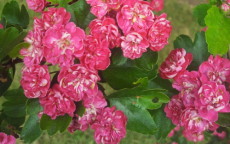Hawthorn trees
Hawthorns are a diverse range of hardy deciduous trees with attractive blossom and fruitlets.
Big Golden Star
An attractive hawthorn, with large red fruits, and usually thornless.- Flowering month: May
- Height after 10 years: 2.5m-3.5m / 8ft-12ft
- Fruit colour: Red
Crataegus pinnatifidaCrataegus arnoldiana
An attractive small hawthorn with masses of white blossom and large edible fruitlets.£72.95buy- Flowering month: May
- Flower colour: White
- Height after 10 years: 2.5m-3.5m / 8ft-12ft
- Fruit colour: Orange / Red
Crataegus arnoldianaCrataegus monogyna
A hardy native hawthorn species, with white blossom and red haws, and particularly attractive to bees.- Flowering month: May
- Flower colour: White
- Height after 10 years: 3m-5m / 10ft-16ft
- Fruit colour: Red - dark
Crataegus monogynaCrataegus schraderiana
This small hawthorn from south-eastern Europe features white flowers and large red edible fruits.- Flowering month: May
- Flower colour: White
- Height after 10 years: 3m-5m / 10ft-16ft
- Fruit colour: Crimson
- Fruit colour: Red - dark
Crataegus schraderianaCrimson Cloud
Crimson Cloud has dark red flowers with white centres.£72.95buy- Flowering month: May
- Flower colour: Red - dark
- Height after 10 years: 3m-5m / 10ft-16ft
- Fruit colour: Red
Crataegus laevigataGlastonbury Thorn
The Glastonbury Thorn, Crataegus Biflora, is a form of the common hawthorn found in the area around Glastonbury, reputed to have been planted by Joseph of Arimathea.- Flowering month: January
- Flowering month: April
- Flowering month: December
- Flower colour: Cream
- Height after 10 years: 3m-5m / 10ft-16ft
- Fruit colour: Red - dark
Crataegus monogynaPaul's Scarlet
A popular small hawthorn with distinctive dark pink blossom with white centres.£44.50 - £72.95buyBest seller- Flowering month: May
- Flower colour: Pink - dark
- Height after 10 years: 3m-5m / 10ft-16ft
- Fruit colour: Red
- Awards: RHS AGM (current)
Crataegus laevigataPrunifolia Splendens
Prunifolia Splendens is one of the best hawthorns for autumn colour and persistent red fruits.- Flowering month: May
- Height after 10 years: 3m-5m / 10ft-16ft
- Fruit colour: Orange / Red
Crataegus persimilisRosea Flore Pleno
A popular ornamental hawthorn, featuring pink double flowers with cream centres.£44.50 - £72.95buyBest seller- Flowering month: May
- Flower colour: Pink
- Height after 10 years: 3m-5m / 10ft-16ft
- Awards: RHS AGM (current)
Crataegus laevigata
How to choose Hawthorn trees
Hawthorns form the genus Crataegus, and are a diverse range of hardy trees, adaptable to many situations - including urban and coastal planting. All have excellent spring blossom displays, and most have attractive autumn fruitlet colours.
Hawthorns flower very late in the spring, usually in May. Hawthorn blossom is usually unscented, or has a very mild scent.
Hawthorns are particularly useful for encouraging wildlife - the flowers attract bees, the leaves support moth caterpillars, and the autumn berries are useful for birds . Some varieties have edible fruitlets suitable for human consumption - used for fruit jellies.
If you have rabbits in the vicinity be sure to protect the trees, as rabbits like to eat young hawthorn bark.
If planting 1-year bare-root hawthorns, cut the main stem at about 1.3m - 1.75m to stimulate side shoots the following year. Pot-grown trees have already had this formative training at the nursery and do not need pruning.





